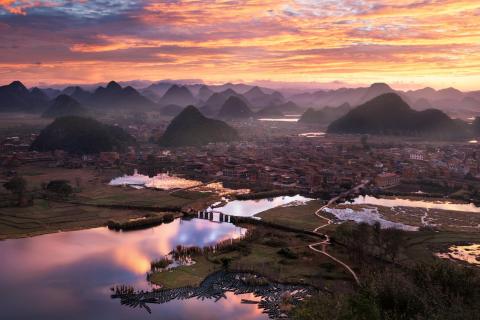Four Seasons Tour of Yunnan, Strolling through Twelve Moments in the Colorful Clouds_02
In this mysterious and enchanting land, each season unveils a unique masterpiece, showcasing the rich and diverse beauty of nature. From the sunny days of spring to the dancing snowflakes of winter, Yunnan deeply captivates the hearts of travelers with its unique landscapes and rich culture.

7. July - Bamei

Described as the secluded paradise in the writings of Tao Yuanming, Bamei is located at the junction of Bada Township and Ake Township in the northern part of Guangnan County, Wenshan Prefecture, Yunnan. Throughout history, the village of Bamei has maintained a nearly exclusive connection with the outside world through a limestone karst cave, remaining isolated for an extended period.
Generations in Bamei have lived in this secluded environment, presenting a picturesque scene of agrarian society with men tilling the fields, women weaving, and a harmonious atmosphere where chickens and dogs coexist. It stands as a rare "paradise on Earth" in 21st-century China. The most enchanting season in Bamei is summer, as July unveils the captivating landscapes.
For detailed Bamei travel tips, please refer to the following link:
8. August - Puzhehei

With thousands of acres of lotus flowers in full bloom, Puzhehei boasts a landscape with rivers and lakes interweaving amid lush green mountains. Winding waterways meander through the vast expanse, and the lotus flowers bloom in delicate shades of pink, creating an elegant spectacle across the lake. Puzhehei, inhabited by the simple Yi ethnic villagers, features interesting folk festivals, ancient villages, cave landscapes, and pastoral scenery, making it another secluded paradise in the land of Yunnan.
June to September marks the golden season for Puzhehei tourism. Over sixty thousand acres of red and white lotus flowers burst into full bloom in the water, presenting a stunning view.
For detailed Puzhehei travel tips, please refer to the following link:
9. September - Nujiang Grand Canyon

Not lamenting autumn, not enduring winter; the Nujiang Grand Canyon, cradled between the 4000-meter-high Gaoligong Mountain and the Biluo Snow Mountain, features the rushing waters of the Nujiang River. The canyon is dotted with dangerous rapids, steep mountain slopes on both sides, and layers of peaks. Here, you will strongly feel the grandeur, peril, beauty, uniqueness, seclusion, vastness, and magnificence of the Grand Canyon, as well as the pure, beautiful, and magical natural landscapes and local customs, expressed by the saying "Different scenery every ten miles, different customs every hundred miles."
Contrary to the melancholy often associated with autumn, the Nujiang Grand Canyon in the fall is rich in color, with a comfortable climate, swift-flowing waters, and a unique charm.
For detailed Nujiang Grand Canyon travel tips, please refer to the following link:
10.October: Tengchong

Golden Gingko Village, dyed with autumn in the woods. Tengchong, a small and exquisite county town, with intertwining streets and a blend of old houses and new buildings, is a must-pass place from Yunnan to Myanmar, India, and Thailand.
"Overseas Chinese Hometown" is another name for it. Here lies the resting place of countless heroes, with towering volcanoes, splashing hot springs, golden Gingko Village, and beautiful wetlands. This is Tengchong, a beautiful border town in the west of Yunnan. This small town is tranquil and peaceful, simple and leisurely. In autumn, the ginkgo leaves turn golden, reaching the pinnacle of beauty.
For Tengchong travel tips, please refer to the following link:
11.November: Yuanyang

Misty terraces in a secluded landscape. Yuanyang is located in the southern part of Ailao Mountain in Yunnan, with 170,000 acres of terraced landscapes stretching across the Honghe area. It is a masterpiece left by the Hani people for generations. The best time to photograph the terraces is from November to April, with the most beautiful scenery in January and February. Around the Chinese New Year, there is often a sea of clouds. Before and after the Lantern Festival, wild cherry blossoms, wild kapok flowers, wild peach blossoms, and pear blossoms bloom profusely. The mushroom houses of the Hani people in Yuanyang, built naturally along the mountains, are a local feature.
Winter is a lesser-known season to visit Yuanyang's terraces. However, even in winter, the average temperature can reach 12 degrees. The breathtaking sunrise and sunset in winter create a fairyland of irresistible charm.
For Yuanyang travel tips, please refer to the following link:
12. December: Xishuangbanna

Bamboo under the moonlight, a kingdom of plants. Here, the nearly hundred-meter-tall Wannian Tree, lush banyan trees all year round, dancing grass that responds to music, and mysterious fruits that can alter your taste buds; this is the habitat of wild animals, where peacocks and elephants are dearly loved; this is the paradise of the Dai people, with bamboo houses nestled in the primeval forest, graceful Dai girls, and the elegant dance of peacocks adding a touch of charm. This is Xishuangbanna, a beautiful oasis on the Tropic of Cancer.
Xishuangbanna has a tropical rainforest climate, with no scorching heat in summer and no severe cold in winter. The air is fresh, showcasing both the beautiful tropical scenery and the colorful ethnic customs. It is suitable for tourism throughout the year, but winter might be a slightly better time to visit.
For Xishuangbanna travel tips, please refer to the following link:







